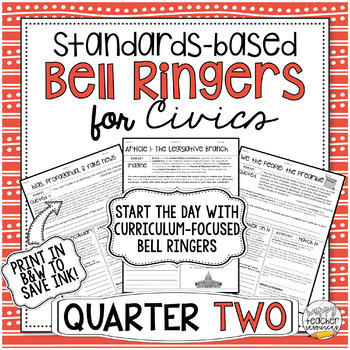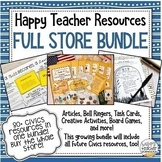Standards-Based Bell Ringers for Civics & American Government: Quarter Two
- PDF
- Easel Activity
What educators are saying
Also included in
- Get a full year's curriculum of Standards-Based Bell Ringers for Civics & American Government in this bundle! 40 weeks of Civics Bell Ringers are included, with 200 daily prompts designed to help your students think critically and creatively about what they have learned in class. Use to supplemePrice $38.40Original Price $48.00Save $9.60
- This Full Store Civics Bundle includes everything Civics-related in the Happy Teacher Resources TPT store. With over 80 products so far, this bundle offers a wide-range of resources covering so much of your Civics curriculum: everything from articles to board games, station activities to escape roomPrice $250.00Original Price $372.75Save $122.75
Description
These Standards-Based Bell Ringers for Civics and American Government cover everything from Elections and the Electoral College, the Articles of Confederation, the Constitution, and the Legislative Branch! With 10 Weeks of daily prompts, these Bell Ringers provide rigorous and engaging enrichment for American Civics students -- full of critical thinking, creative prompts, test prep, and reflection questions, you can use these Bell Ringers as hooks for lessons, to launch discussions, review materials, and prepare for the Civics End of Course exam!
The Full Collection of Civics Bell Ringers:
Quarter One | Quarter Two | Quarter Three | Quarter Four
Each week is centered around a different benchmark from the Florida Middle School Civics Curriculum, but the questions are challenging enough to be appropriate for high school learners as well. All the topics and standards are listed below. The Bell Ringers are self-contained and can be used in any order!
This resource includes 10 weeks of Bell Ringers, or 50 prompts: 9 weeks worth of Standards-Based enrichment, from Evaluating Candidates and Political Parties, to the Articles of Confederation and the United States Constitution, and a bonus Bell Ringer: "Get Out the Vote!", perfect for during Election week in November, or whenever you have a mock election in your class!
Here are the topics and their corresponding Florida State Standards (which are easily relatable to other states, as well):
1. Get Out the Vote (Bonus Week!)
Students analyze a Thomas Jefferson quote (“We have a government by the majority who participate.”), consider why voting is a benefit of the common good, and decide whether the voting age should be lowered to 16.
2. Let’s Talk Politics | SS.7.CG.2.7 Qualifications for Office, SS.7.CG.2.8 Media, Individual, & Interest Groups Influence on Government, SS.7.CG.3.14 the Electoral College.
Students describe what character traits they would most like to see in a candidate running for President, pretend they’re a member of a student interest group and create an ad for the student newspaper, and consider what would happen if we didn’t have the Electoral College.
3. Bias, Propaganda, and Fake News. | SS.7.CG.2.9 Bias, Symbolism and Propaganda.
Students describe the personality of a dog as written by a cat who is biased against him, identify various types of propaganda used in toothpaste advertisements, and write campaign copy for a politician using four different types of propaganda: bandwagon, plain folks, testimonial, and glittering generalities.
4. The Articles of Confederation | SS.7.CG.1.7 Articles of Confederation. Students consider what America would look like today if we had kept the Articles of Confederation, describe how the weaknesses of the Articles led to Shays’ Rebellion, and connect the colonists’ treatment by King George to their desire to create a government without a strong central ruler.
5. We the People: The Preamble | SS.7.CG.1.8 Preamble of the U.S. Constitution.
Students match scenarios with purposes of government stated in the Preamble to the Constitution, identify vocabulary from the Preamble they’re unfamiliar with, and rewrite excerpts from the Preamble as tweets.
6. The United States Constitution | SS.7.CG.1.9 Structure of the U.S. Constitution, SS.7.CG.3.3 The Three Branches of Government, SS.7.CG.3.5The Amendment Process.
Students learn about the structure of the Constitution by considering how the separation of powers helps keep people free, choosing which branch of government they would most like to work for, and answering the question, “If you could encourage one person in your life to run for President, who would it be?”
7. Check, Please! Checks and Balances | SS.7.CG.1.9 Limits on Government Powers.
Students predict what might happen if each branch of government was allowed to operate unchecked, answer a test prep question, and consider the importance of the free press as the fourth check in our government.
8. Ratifying the Constitution | SS.7.CG.1.10 Federalists versus Anti-Federalists.
Students design t-shirt slogans for Federalist and Anti-Federalist rallies, predict what might have happened if the Anti-Federalists hadn’t gotten the Bill of Rights added to the Constitution, and connect a quote from the Federalist Papers to John Locke’s Social Contract.
9. Article I: The Legislative Branch | SS.7.CG.3.7 The Legislative Branch
Students describe what law they would create if they were a Congressperson, identify positive qualities within themselves that would make them good Representatives of their community, and illustrate the enumerated powers of Congress.
10. How a Bill Becomes a Law | SS.7.CG.3.7 The Legislative Branch
Students consider why it’s difficult to get bills passed through a divided Congress, gauge whether they think the lawmaking process is too difficult or if it's appropriately thorough, and describe whether or not they think they would be capable of filibustering in the Senate for hours on end — and, if they had to talk for hours, what topic they love most to talk about!
Download a free sample week of Bell Ringers here!
This resource comes as a non-editable PDF, and also contains an optional Bell Ringer Cover Sheet and Student Contract, as well as a handy grading sheet with student and teacher reflection!
A digital version is also available through TPT Easel! TPT Easel Activities can be assigned directly to your Google Classroom, or you can generate a link to share with students via email or your school's LMS!
If you enjoy this resource, leave a review! Go to “My Purchases” on your TPT account. You can rate the product, leave a review, and collect TPT credits that you can use on other products!
Other Happy Teacher Resources you might enjoy:
✩ Standards-Based Bell Ringers for Civics & American Government | Quarter One
✩ Standards-Based Bell Ringers for Civics & American Government | Quarter Three
✩ The Colonists' Library | Foundations of Government: Influential Documents
✩ Pathway to Citizenship Board Game | Naturalization Process Game for Civics!
✩ Escape From King George! American Revolution Escape Room
Follow Happy Teacher Resources so you're the first to know when new products are available!
You can also follow my social media: Instagram | Pinterest | Facebook








